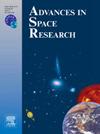An ionospheric VTEC forecasting model over China based on the kernel ridge regression
IF 2.8
3区 地球科学
Q2 ASTRONOMY & ASTROPHYSICS
引用次数: 0
Abstract
Forecasting Vertical Total Electron Content (VTEC) is critical for understanding ionospheric processes and improving wireless communication systems. To enhance the forecast accuracy of the VTEC model, we propose a short-term forecasting model using Kernel Ridge Regression (KRR) to improve VTEC predictions with data from China. This model has the following characteristics: 1) It addresses the nonlinear nature of VTEC and reduces multicollinearity using a kernel function; 2) The ridge regression approach prevents overfitting; 3) It effectively handles the nonlinear relationship between VTEC and input variables. We compared the proposed model with the Decision Tree (DT), Random Forest (RF), Long Short-Term Memory Network (LSTM), and the International Reference Ionosphere (IRI) model. Overall, the KRR model achieved lower Root Mean Squared Error (RMSE) compared to the DT, RF, LSTM, and IRI-2016 models, with reductions of 0.55 TECU, 0.43 TECU, 0.17 TECU, and 6.95 TECU, respectively. In the 2019 datasets, the KRR model showed significant improvements in performance in regions like Sanya (31.3%, 27.78%, 10.11%, 86.02%), Wuhan (33.71%, 26.58%, 15.33%, 83.93%), Beijing (30.4%, 25.64%, 15.53%, 84.12%), and Mohe (37.72%, 29.70%, 11.25%, 76.41%) compared to DT, RF, LSTM, and IRI-2016 models. The proposed KRR model offers a new approach to improving VTEC forecasting accuracy, demonstrating clear advantages over existing models.
基于核脊回归的中国电离层VTEC预报模式
预测垂直总电子含量(VTEC)对于理解电离层过程和改进无线通信系统至关重要。为了提高VTEC模型的预报精度,本文提出了一种利用核脊回归(Kernel Ridge Regression, KRR)的短期预报模型,以提高中国VTEC的预报精度。该模型具有以下特点:1)解决了VTEC的非线性特性,利用核函数减少了多重共线性;2)脊回归方法防止过拟合;3)有效处理了VTEC与输入变量之间的非线性关系。我们将该模型与决策树(DT)、随机森林(RF)、长短期记忆网络(LSTM)和国际参考电离层(IRI)模型进行了比较。总体而言,与DT、RF、LSTM和IRI-2016模型相比,KRR模型的均方根误差(RMSE)更低,分别降低了0.55 TECU、0.43 TECU、0.17 TECU和6.95 TECU。在2019年的数据集中,与DT、RF、LSTM和IRI-2016模型相比,KRR模型在三亚(31.3%、27.78%、10.11%、86.02%)、武汉(33.71%、26.58%、15.33%、83.93%)、北京(30.4%、25.64%、15.53%、84.12%)和漠河(37.72%、29.70%、11.25%、76.41%)等地区的表现均有显著提高。提出的KRR模型为提高VTEC预报精度提供了新的途径,与现有模型相比具有明显的优势。
本文章由计算机程序翻译,如有差异,请以英文原文为准。
求助全文
约1分钟内获得全文
求助全文
来源期刊

Advances in Space Research
地学天文-地球科学综合
CiteScore
5.20
自引率
11.50%
发文量
800
审稿时长
5.8 months
期刊介绍:
The COSPAR publication Advances in Space Research (ASR) is an open journal covering all areas of space research including: space studies of the Earth''s surface, meteorology, climate, the Earth-Moon system, planets and small bodies of the solar system, upper atmospheres, ionospheres and magnetospheres of the Earth and planets including reference atmospheres, space plasmas in the solar system, astrophysics from space, materials sciences in space, fundamental physics in space, space debris, space weather, Earth observations of space phenomena, etc.
NB: Please note that manuscripts related to life sciences as related to space are no more accepted for submission to Advances in Space Research. Such manuscripts should now be submitted to the new COSPAR Journal Life Sciences in Space Research (LSSR).
All submissions are reviewed by two scientists in the field. COSPAR is an interdisciplinary scientific organization concerned with the progress of space research on an international scale. Operating under the rules of ICSU, COSPAR ignores political considerations and considers all questions solely from the scientific viewpoint.
 求助内容:
求助内容: 应助结果提醒方式:
应助结果提醒方式:


